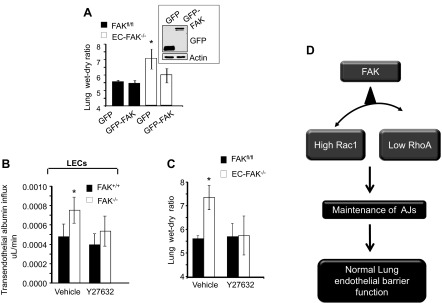Fig. 5.

Blockade of RhoA reinstates lung vascular permeability. A: restoration of FAK expression in EC-FAK−/− mice rescues lung vascular permeability. FAKfl/fl or EC-FAK−/− mice expressing indicated constructs were assessed for lung edema formation by determining lung wet-to-dry weight ratios. Graph represents means ± SD. *Significance from GFP or GFP-FAK transducing FAKfl/fl lungs or GFP-FAK transducing EC-FAK−/− lungs (P < 0.05, n = 4). Inset shows representative immunoblots of free GFP or GFP-FAK fusion protein found in lung lysates from EC-FAK−/− mice with the aid of an anti-GFP antibody. A representative immunoblot from 4 mouse lungs/group is shown. All experiments were performed 48 h after injection of liposome-encapsulated mutants. B and C: inhibition of RhoA signaling rescues endothelial barrier function in FAK-depleted ECs and lungs. B: FAK+/+ or FAK−/− LEC monolayers were pretreated with vehicle or 10 μM ROCK inhibitor Y-27632 to inhibit ROCK. After 30 min, transendothelial albumin influx was determined using Evans blue-conjugated albumin. Experiments were performed in duplicate at least three times. *Significant difference from FAK+/+ LECs (P < 0.05). C: FAKfl/fl or EC-FAK−/− mice were retro-orbitally injected with either vehicle or ROCK inhibitor Y-27632 (10 mg/kg). Mice were killed after 30 min, and lung wet-to-dry weight ratio was calculated. *Significance from PBS- or Y-27632-exposed FAKfl/fl lungs or EC-FAK−/− lungs receiving Y-27632 (P < 0.05; n = 3–4 mice/group). D: model of endothelial FAK regulation of lung vascular permeability described in text.
